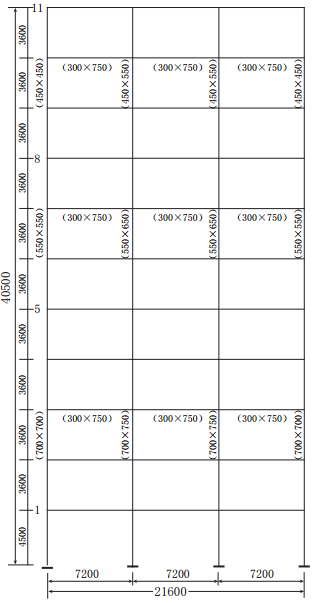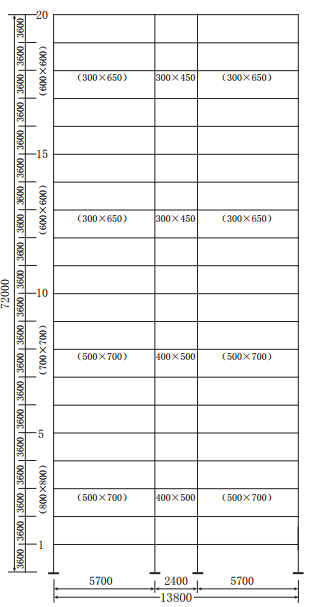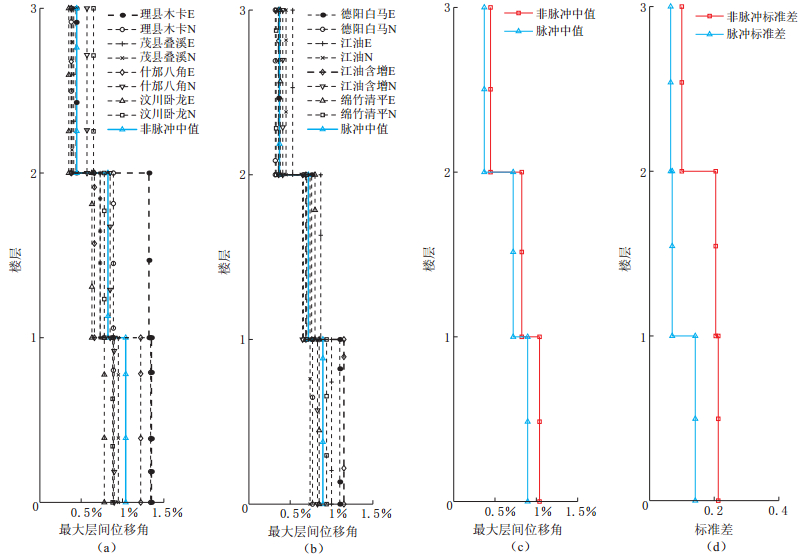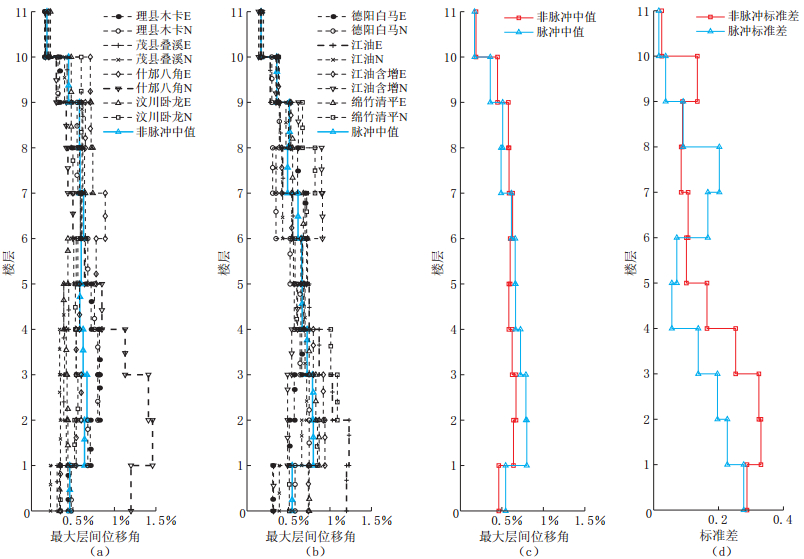Analysis of the seismic response characteristics of building structures subjected to near-fault ground motions from Wenchuan earthquake
-
摘要: 研究了具有不同自振特性的建筑结构在近断层速度脉冲型及非速度脉冲型地震动作用下的结构层间变形分布,揭示了近断层速度脉冲对工程结构地震响应的特殊影响. 从汶川MS8.0地震近断层强震记录中选取两组典型速度脉冲型记录和非脉冲型记录, 根据确定的目标地震动强度水平,利用时域叠加小波函数法对选择的强震记录进行调整, 使之与目标地震动水平对应的加速度反应谱保持一致, 以此作为结构地震反应分析的地震动输入. 选取具有不同自振特征的3层、11层和20层典型钢筋混凝土框架结构, 建立有限元分析模型, 分别计算在速度脉冲型与非速度脉冲型记录作用下这些结构层间变形分布. 研究表明,速度脉冲型记录与非速度脉冲型记录作用下结构层间变形有明显差异, 且与结构自振特征有关.就低层结构的层间变形而言, 非速度脉冲型记录的影响较速度脉冲型记录的影响大. 随着结构自振周期的增加, 高阶振型的影响更加明显. 与非速度脉冲型记录相比,速度脉冲型记录的结构层间位移反应中值及离散程度较大. 速度脉冲型记录更容易激发高层结构的高阶振型, 产生较大的层间位移反应. 非速度脉冲型记录对中低层结构层间变形影响较大.因此, 在开展近断层结构地震影响评价时, 应考虑近断层速度脉冲的影响.Abstract: This paper focuses on studying the effects of near-fault ground velocity pulses on building structures. Inter-story drift distributions of structures subjected to velocity pulse-type records and non-pulse-type records were investigated to reveal the effects of near-fault strong motions on building structures with different natural vibration periods. Two groups of typical velocity pulse records and non-pulse records were selected from Wenchuan MS8.0 earthquake, and a wavelet method of time domain synthesizing was used to modify the selected records, matching the target spectra from determined seismic intensity. The modified ground motions were used as the basic strong motion data for seismic response analysis. Finite models of 3, 11 and 20-story RC frame structures were established, and inter-story drift distributions of these three buildings subjected to typical velocity pulse-type records and non-pulse-type records were investigated. The study reveals that the inter-story drift distributions are quite different when the structures are subjected to pulse-type records and non-pulse-type records for the 3, 11 and 20-story RC frame structures, and are correlated with the natural vibration properties of building structures. In terms of low-rise buildings, inter-story drifts are larger for non-pulse-type records than those for pulse-type records. The influences of high modes on inter-story drifts become much more obvious with the increase of story number. The median value and dispersion of inter-story drifts are much larger when subjected to pulse-type records compared with non-pulse-type records for high-rise buildings. Pulse-type records tend to induce higher modes response, resulting in large inter-story drifts for high-rise buildings. Non-pulse-type records have relatively large effects on inter-story drifts primarily in the fundamental mode for low-rise buildings. It can be concluded that the effects of near-fault velocity pulses should be taken into consideration when assessing seismic damage potential for near-fault building structures.
-
Keywords:
- velocity pulses /
- near-fault /
- frame structure /
- inter-story drift
-
-
图 1 GB50011-2001设计反应谱(目标谱)和原始强震记录加速度反应谱(a) 原始非速度脉冲型记录加速度反应谱; (b) 原始速度脉冲型记录加速度反应谱;(c) 原始记录的平均加速度反应谱
Figure 1. GB50011-2001 design spectrum (target spectrum) and acceleration response spectrum of original ground motions(a) Original non-pulse-type acceleration response spectrum; (b) Original pulse-type acceleration response spectrum; (c) Mean response spectrum of scaled ground motions
图 3 GB50011-2001设计反应谱(目标谱)和调整后强震记录加速度反应谱(a) 调整后非速度脉冲型记录加速度反应谱; (b) 调整后速度脉冲型记录加速度反应谱; (c)调整后记录的平均加速度反应谱
Figure 3. GB50011-2001 design spectrum (target spectrum) and modified acceleration response spectrum of ground motions (a) Modified non-pulse-type ground motions; (b) Modified pulse-type ground motions; (c) Mean response spectrum of scaled ground motions
图 7 调整后地震动作用下3层结构最大层间位移角(a) 非速度脉冲型地震动; (b) 速度脉冲型地震动; (c) 中值比较; (d) 标准差比较
Figure 7. Maximum inter-story drift for a 3-story building subjected to modified ground motions (a) Non-pulse-type ground motions; (b) Pulse-type ground motions; (c) Comparison between median values; (d) Dispersion comparison of maximum inter-story drift ratio (IDR)
图 8 调整后地震动作用下11层结构最大层间位移角(a) 非速度脉冲型地震动; (b) 速度脉冲型地震动; (c) 中值比较; (d) 标准差比较
Figure 8. Maximum inter-story drift for an 11-story building subjected to modified ground motions(a) Non-pulse-type ground motions; (b) Pulse-type ground motions; (c) Comparison between median values; (d) Dispersion comparison
图 9 调整后地震动作用下20层结构最大层间位移角(a) 非速度脉冲型地震动; (b) 速度脉冲地震动; (c) 中值比较; (d) 标准差比较
Figure 9. Maximum inter-story drift for a 20-story building subjected to modified ground motions (a) Non-pulse-type ground motions; (b) Pulse-type ground motions; (c) Comparison between median values; (d) Dispersion comparison of IDR
表 1 选取的近断层速度脉冲型记录的主要参数
Table 1 Parameters of selected near-fault pulse-type ground motions from Wenchuan earthquake

表 2 选取的近断层非速度脉冲型记录的主要参数
Table 2 Parameters of selected non-pulse-type ground motions from Wenchuan earthquake

-
李爽, 谢礼立. 2006. 近场脉冲型地震动对钢筋混凝土框架结构影响[J]. 沈阳建筑大学学报, 22(3): 406-410. 国家质量监督检验检疫总局, 中华人民共和国建设部. 2001. GB50011-2001建筑抗震设计规范[S]. 北京: 中国建筑工业出版社: 44-56. 全伟, 李宏男. 2008. 调整已有地震动拟和规范反应谱人造地震动方法比较[J]. 防灾减灾工程学报, 28(1): 91-97. 谢俊举, 温增平, 高孟潭, 袁美巧, 何少林. 2011. 2008年汶川地震近断层地震动的非平稳特征[J]. 地球物理学报, 54(3): 728-736. 杨迪雄, 潘建伟, 李刚. 2009. 近断层脉冲型地震动作用下建筑结构的层间变形分布特征和机理分析[J]. 建筑结构学报, 30(4): 108-118. 杨迪雄, 赵岩. 2010. 近断层地震动破裂向前方向性与滑冲效应对隔振建筑结构抗震性能的影响[J]. 地震学报, 32(5): 579-587. 于海英, 王栋, 杨永强, 卢大伟, 解全才, 张明宇, 周宝峰, 江纹乡, 程翔, 杨剑. 2008. 汶川8.0级地震强震动特征初步分析[J]. 震灾防御技术, 3(4): 321-336. 赵凤新, 韦韬, 张郁山. 2008. 近断层速度脉冲对钢筋混凝土框架结构地震反应的影响[J]. 工程力学, 25(10): 180-187. Alavi B, Krawinkler H. 2004. Behavior of moment resisting frame structures subjected to near-fault ground motions[J]. Earthq Eng Struct Dyn, 33(6): 687-706.
American Society of Civil Engineers. 2006. Minimum Design Loads for Buildings and Other Structures. ASCE 7-05 [S]. Reston, Virginia, United States: American Society of Civil Engineers: 175-176.
Baker J K. 2007. Quantitative classification of near-fault ground motion using wavelet analysis[J]. Bull Seism Soc Amer, 97(5): 1486-1501.
Bertero V V, Mahin S A, Hrrera R A. 1978. Aseismic design implications of near-fault San Fernando earthquake records[J]. Earthq Eng Struc Dyn, 6(1): 31-42.
Chen K C, Huang B S, Wang J H, Huang W G, Chang T M, Hwang R D, Chiu H C, Peter Tsai C C. 2001. An observation of rupture pulses of the 20 September 1999 Chi-Chi, Taiwan, earthquake from near-field seismograms[J]. Bull Seism Soc Amer, 91(5): 1247-1254.
Hancock J, Watson-L J, Abrahamson N A, Bommer J J, Markatis A, Mccoy E, Mendis R. 2006. An improved method of matching response spectra of recorded earthquake ground motion using wavelets[J]. J Earthq Eng, 10(1): 67-89.
Huang B S, Chen K C, Wang J H, Huang W G, Wang J H, Chang T M, Hwang R D, Chiu H C, Peter Tsai C C. 2000. Characteristics of strong ground motion across a thrust fault tip from the September 21, 1999, Chi-Chi, Taiwan earthquake[J]. Geophys Res Lett, 27: 2729-2732.
Iwan W D, Chen X. 1994. Important near-field ground motion data from the Landers earthquake[C]//Proceedings of the 10th European Conference on Earthquake Engineering. Vienna: 229-234.
Iwan W D. 1997. Drift spectrum: Measure of demand for earthquake ground motions[J]. J Struct Eng, 123(4): 397-404.
Kalkan E, Kunnath S K. 2006. Effects of fling step and forward directivity on seismic response of buildings[J]. Earthquake Spectra, 22(2): 367-390.
Kalkan E, Luco N. 2011. Special issue on earthquake ground-motion selection and modification for nonlinear dynamic analysis of structures[J]. J Struct Eng, 137(3): 277, doi:10.10611(ASCE)ST.1943-541X.0000355.
Li X J, Zhou Z H, Huang M, Wen R Z, Yu H Y, Lu D W, Zhou Y N, Cui J W. 2008. Preliminary analysis of strong-motion recordings from the magnitude 8.0 Wenchuan, China, earthquake of May 12[J]. Seism Res Lett, 79(6): 844-854.
Li X J, Liu L, Wang Y S, Yu T. 2010. Analysis of horizontal strong-motion attenuation in the great 2008 Wenchuan earthquake[J]. Bull Seism Soc Amer, 100(5B): 2440-2449.
Lu M, Li X J, An X W, Zhao J X. 2010. A preliminary study on the near-source strong-motion characteristics of the great 2008 Wenchuan earthquake[J]. Bull Seism Soc Amer, 100(5B): 2491-2507.
MacRac G A, Morrow D V, Roder C W. 2000. Near-fault ground motion effects on simple structures[J]. J Struct Eng, 127(9): 996-1004.
Malhotra P K. 1999. Response of buildings to near field pulse-like ground motions[J]. Earthq Eng Struct Dyn, 28(11): 1309-1326.
Mukherjee S, Gupta V K. 2002. Wavelet-based generation of spectrum-compatible time-histories[J]. Soil Dyn Earthq Eng, 22(9-12): 799-804.
Reinhorn A M, Kunnath C K, Valles R E, Li C, Madan A. 2006. IDARC2D Version 6.1: A Program for the Inelastic Damage Analysis of Buildings[M]. Buffalo, New York: State University of New York: 1-62.
Somerville P. 1995. Characterization of Ground Motion at the Sites of Subjected Buildings[R]. SAC Joint Venture Rep, SAC 95-03.
Somerville P G, Smith N F, Graves R W, Abrahamson N A. 1997. Modification of empirical strong ground motion attenuation relations to include the amplitude and duration effects of rupture directivity[J]. Seism Res Lett, 68(1): 199-222.
Suarez L E, Montejo L A. 2005. Generation of artificial earthquakes via the wavelet transform[J]. Int J Solids Struct, 42(5): 5905-59l9.
Wen Z P, Xie J J, Gao M T, Hu Y X, Chau K T. 2010. Near-source ground motion characteristics of the MS8.0 Wenchuan earthquake[J]. Bull Seism Soc Amer, 100(5B): 2425-2439.





 下载:
下载:








